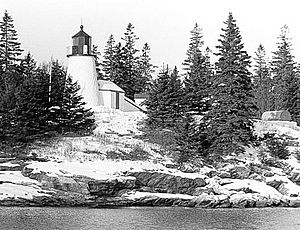Burnt Island Light facts for kids
 |
|
| Location | Burnt Island SSW of Boothbay Harbor, Maine |
|---|---|
| Coordinates | 43°49′30.7″N 69°38′24.8″W / 43.825194°N 69.640222°W |
| Year first constructed | 1821 |
| Year first lit | 1821 |
| Automated | 1989 |
| Foundation | Surface rock |
| Construction | Granite w/brick lining |
| Tower shape | Conical |
| Markings / pattern | White w/black lantern |
| Height | 30 feet (9.1 m) |
| Focal height | 61 feet (19 m) |
| Range | R 12 nautical miles (22 km; 14 mi), W 15 nautical miles (28 km; 17 mi) |
| Characteristic | Flashing red 6 sec w/ two white sectors |
| Fog signal | HORN: 1 every 10s |
The Burnt Island Light, built in 1821, is one of the oldest lighthouses still standing in Maine. It's a special place because it has a living history museum where you can learn what life was like for lighthouse keepers long ago. This historic lighthouse was added to the National Register of Historic Places in 1977.
Contents
History of Burnt Island Light
Burnt Island is located at the western entrance to Boothbay Harbor. This is a large natural harbor with the town of the same name nearby. The island got its name because people used to burn its plants. This helped keep the land clear for sheep to graze.
Building the Lighthouse
In March 1821, money was set aside to build a lighthouse for Boothbay Harbor. Town officials and ship pilots asked for a lighthouse on the island. Within days, the island was bought. A tower made of granite and lined with brick was built. A stone house for the lighthouse keeper was also built.
Later that summer, the light was turned on for the first time. It used a system of whale oil lamps and curved mirrors. This was a common way to light lighthouses back then.
Changes Over Time
The original keeper's house was replaced in 1857. The new house, made of wood, is still there today. A covered walkway connected the house to the tower. At the same time, a special Fresnel lens was put in. This lens made the light much brighter and more focused.
The light first shone as a steady white beam. Its main purpose was to attract ships to the harbor. In 1888, part of the light was blocked. This was to prevent ships coming from the south from seeing it too early. It helped them avoid dangerous rocky islands.
A year later, the light changed again. It became a steady red light with two white sections. These white sections showed safe paths around Squirrel Island. This caused confusion with another nearby lighthouse, the Ram Island Light. So, in 1901, the steady light was removed. A spinning light with a lens on each side was put in its place. This spinning light was used until 1962. It was then moved to a museum. An electric light replaced it. Burnt Island Light was the last lighthouse in Maine to switch from kerosene to electricity.
Fog Signals and Automation
In 1895, a tall wooden tower was built to hold a fog bell. This tower was taken down in 1962. The bell was then moved to a metal frame. An electric striker rang the bell instead of old clockwork. The entire lighthouse station became automated in 1988. This meant that lighthouse keepers were no longer needed to live there. It was one of the last lighthouses in Maine to be automated.
Visiting the Lighthouse Today
In 1998, the island and its lighthouse were given to the State of Maine. This was part of the Maine Lighthouse Program. The buildings have been carefully fixed up to look like they did in the 1950s. In 2003, a "living history" program started. This program lets visitors experience what life was like for lighthouse keepers and their families. It's a fun way to learn about the past!
See also


